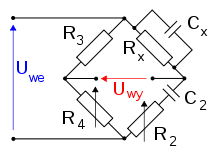Wien bridge: Difference between revisions
| Line 22: | Line 22: | ||
{{see also|Wien bridge oscillator}} |
{{see also|Wien bridge oscillator}} |
||
If the bridge is constructed such that R<sub>x</sub> = R<sub>2</sub>, C<sub>x</sub> = C<sub>2</sub> and R<sub>4</sub> = 2R<sub>3</sub>, the AC signal U<sub>wy</sub> is exactly one sixth of the applied signal U<sub>we</sub>. If an [[amplifier|amplifying]] circuit is connected such that U<sub>wy</sub> is connected to its input and U<sub>we</sub> is connected to its output and provided the amplifying circuit has a gain of six, then a steady oscillation will be maintained at a frequency of (ω/2π) Hertz (The ω comes from the balance equation above). In a practical arangement, some means has to be provided of stabilising the output. This circuit has the advantage, that because of the low gain required by the amplifing circuit, it has a very low distortion of the generated sine wave. |
If the bridge is constructed such that R<sub>x</sub> = R<sub>2</sub>, C<sub>x</sub> = C<sub>2</sub> and R<sub>4</sub> = 2R<sub>3</sub>, the AC signal U<sub>wy</sub> is exactly one sixth of the applied signal U<sub>we</sub>. If an [[amplifier|amplifying]] circuit is connected such that U<sub>wy</sub> is connected to its input and U<sub>we</sub> is connected to its output and provided the amplifying circuit has a gain of six giving a loop gain of unity, then a steady oscillation will be maintained at a frequency of (ω/2π) Hertz (The ω comes from the balance equation above). In a practical arangement, some means has to be provided of stabilising the output and making the loop gain greater than unity for startup. This circuit has the advantage, that because of the low gain required by the amplifing circuit, it has a very low distortion of the generated sine wave. |
||
== See also == |
== See also == |
||
Revision as of 12:54, 12 November 2015

The Wien bridge is a type of bridge circuit that was developed by Max Wien in 1891.[1] The bridge comprises four resistors and two capacitors.
Bridge circuits were a common way of measuring component values by comparing them to known values. Often an unknown component would be put in one arm of a bridge, and then the bridge would be nulled by adjusting the other arms or changing the frequency of the voltage source. See, for example, the Wheatstone bridge.
The Wien bridge is one of many common bridges.[2] Wien's bridge is used for precison measurement of capacitance in terms of resistance and frequency.[3] It was also used to measure audio frequencies.
The Wien bridge does not require equal values of R or C. At some frequency, the reactance of the series R2–C2 arm will be an exact multiple of the shunt Rx–Cx arm. If the two R3 and R4 arms are adjusted to the same ratio, then the bridge is balanced.
The bridge is balanced when:[4]
- and
The equations simplify if one chooses R2 = Rx and C2 = Cx; the result is R4 = 2 R3.
In practice, the values of R and C will never be exactly equal, but the equations above show that for fixed values in the 2 and x arms, the bridge will balance at some ω and some ratio of R4/R3.
Use in an Oscillator
If the bridge is constructed such that Rx = R2, Cx = C2 and R4 = 2R3, the AC signal Uwy is exactly one sixth of the applied signal Uwe. If an amplifying circuit is connected such that Uwy is connected to its input and Uwe is connected to its output and provided the amplifying circuit has a gain of six giving a loop gain of unity, then a steady oscillation will be maintained at a frequency of (ω/2π) Hertz (The ω comes from the balance equation above). In a practical arangement, some means has to be provided of stabilising the output and making the loop gain greater than unity for startup. This circuit has the advantage, that because of the low gain required by the amplifing circuit, it has a very low distortion of the generated sine wave.
See also
References
- ^ Wien 1891
- ^ Terman 1943, p. 904
- ^ Terman 1943, p. 904 citing Ferguson & Bartlett 1928
- ^ Terman 1943, p. 905
- Ferguson, J. G.; Bartlett, B. W. (July 1928), "The Measurement of Capacitance in Terms of Resistance and Frequency" (PDF), Bell System Technical Journal, 7 (3): 420–437, doi:10.1002/j.1538-7305.1928.tb01234.x
- Terman, Frederick (1943), Radio Engineers' Handbook, McGraw-Hill
- Wien, M. (1891), "Messung der Inductionsconstanten mit dem "optischen Telephon" (Measurement of Inductive Constants with the "Optical Telephone")", Annalen der Physik und Chemie (in German), 280 (12): 689–712, Bibcode:1891AnP...280..689W, doi:10.1002/andp.18912801208


